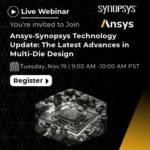My first job out of college was migrating a DRAM chip from one process node to a newer node, and it was a 100% manual process that required many months of effort. That need to migrate semiconductor IP to newer nodes is still with us today, and much automation has been applied to digital circuits, however migrating analog IP has proven… Read More
Electronic Design Automation
Next Generation of Systems Design at Siemens
Electronic systems design is filled with a wide range of tools used across IC packaging design, multi-board systems, design creation, physical implementation, electro-mechanical co-design, simulation & analysis, and new product introduction. Siemens has been offering tools in this flow for many years now, so I was able… Read More
Signal Integrity Basics
PCB and package designers need to be concerned with Signal Integrity (SI) issues to deliver electronic systems that work reliably in the field. EDA vendors like Siemens have helped engineers with SI analysis using a simulator called HyperLynx, dating all the way back to 1992. Siemens even wrote a 56-page e-book recently, Signal… Read More
My Conversation with Infinisim – Why Good Enough Isn’t Enough
My recent post on a high-profile chip performance issue got me thinking. The root cause of the problem discussed there had to do with a clock tree circuit that was particularly vulnerable to reliability aging under elevated voltage and temperature. Chip aging effects have always got my attention. I’ve lived through a few of them… Read More
Build a 100% Python-based Design environment for Large SoC Designs
In the fast-evolving world of semiconductor design, chip designers are constantly on the lookout for EDA tools that can enhance their productivity, streamline workflows, and push the boundaries of innovation. Although Tcl is currently the most widely used language, it seems to be reaching its limits in the face of the growing… Read More
Keysight EDA 2025 launches AI-enhanced design workflows
The upcoming Keysight EDA 2025 launch has three familiar tracks: RF circuit design, high-speed digital circuit design, and device modeling and characterization. However, this update features a common thread between the tracks – AI-enhanced design workflows. AI speeds modeling and simulation, opening co-optimization for… Read More
CEO Interview: Bijan Kiani of Mach42
Bijan’s role includes overseeing all product groups, field engineering, customer support, strategy, sales, marketing, and business development. His previous appointments include VP of Marketing at Synopsys Design Group and CEO of InCA. He holds a PhD in Electrical Engineering.
Tell us about your company
Mach42 is a verification… Read More
Changing RISC-V Verification Requirements, Standardization, Infrastructure
A lively panel discussion about RISC-V and open-source functional verification highlighted this year’s Design Automation Conference. Part One looked at selecting a RISC-V IP block from a third-party vendor and investigating its functional verification process.
In Part Two, moderator Ron Wilson and Contributing Editor … Read More
Synopsys-Ansys 2.5D/3D Multi-Die Design Update: Learning from the Early Adopters
The demand for high-performance computing (HPC), data centers, and AI-driven applications has fueled the rise of 2.5D and 3D multi-die designs, offering superior performance, power efficiency, and packaging density. However, these benefits come with myriads of challenges, such as multi-physics, which need to be addressed.… Read More
Podcast EP259: A View of the History and Future of Semiconductor Manufacturing From PDF Solution’s John Kibarian
Dan is joined by John Kibarian, president, chief executive officer and co-founder of PDF Solutions. He has served as president since 1991 and CEO since 2000.
John explains the evolution of PDF Solutions from its beginnings in 1992 to the present day. John describes moving from TCAD tools for design teams to a yield optimization … Read More











AI RTL Generation versus AI RTL Verification